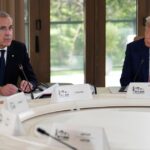In the dimly lit halls of Parliament, the clock is ticking louder on what could be one of the most consequential economic arrangements of the decade. Mark Carney, the former Bank of Canada governor who has increasingly become the Liberal government’s economic voice, acknowledged yesterday what industry insiders have feared for weeks: Canada’s push to secure a critical trade agreement with the United States may miss its August 1 deadline.
Standing before reporters in the National Press Theatre, Carney’s typically confident demeanor gave way to a more measured tone. “We’re working towards that deadline, but ultimately what matters most is getting the right deal for Canadians, not just any deal,” he said, while flanked by Trade Minister Mary Ng.
The timing couldn’t be more precarious. With the U.S. presidential election looming in November and protectionist sentiment surging across political lines, Canadian negotiators are scrambling to lock in guarantees before Washington’s attention fully shifts to campaign mode.
For Sarah Goldfeder, former U.S. diplomat and principal at Earnscliffe Strategies, the window is narrowing dangerously. “Every day closer to the U.S. election reduces our leverage,” she told me during a phone interview from her Ottawa office. “By September, American officials will be politically paralyzed on major trade commitments.”
The stakes for communities across Canada are immense. In Sarnia, Ontario, where cross-border supply chains sustain thousands of manufacturing jobs, city councillor Mike Stark describes a growing unease. “Our local economy breathes with the rhythm of cross-border trade,” Stark explained during a recent community forum I attended. “People here aren’t thinking about policy papers – they’re worried about their mortgages.”
What began as technical discussions around auto parts and agricultural quotas has evolved into something more fundamental: Canada’s economic security in an increasingly unpredictable global landscape. Canadian negotiators are pushing for exemptions from Buy American provisions and seeking guarantees that critical minerals – essential components for everything from electric vehicles to defense systems – will flow smoothly between the two nations.
Data from Statistics Canada underscores our vulnerability – over 75% of our exports head to American markets, representing approximately 20% of our GDP. The integrated auto sector alone supports close to 500,000 Canadian jobs, according to industry association figures.
Behind closed doors, business leaders express frustration at what they perceive as a lack of urgency. “We’ve been raising alarms since January,” said Dennis Darby, president of Canadian Manufacturers & Exporters, during an industry roundtable in Toronto last week. “The government seems to be operating as if time is a luxury we have. It’s not.”
The political calculus is equally complicated. Prime Minister Justin Trudeau’s government, already facing declining popularity, has cast the trade negotiations as evidence of its ability to navigate complex international relationships. A failure to secure favorable terms – or worse, no agreement at all – would hand Conservative leader Pierre Poilievre powerful ammunition heading into the next federal election.
Poilievre hasn’t hesitated to capitalize on the uncertainty. “Another Liberal deadline, another Liberal failure,” he told supporters during a stop in Windsor. “Canadian workers deserve a government that can actually deliver results, not just press conferences.”
The government’s strategy appears to be evolving. Rather than rushing toward the August deadline, officials now suggest a phased approach might be more realistic. “We may see sectoral agreements in areas of mutual priority first, followed by broader arrangements,” explained a senior government official who requested anonymity to discuss sensitive negotiations.
Carney’s involvement itself signals the high stakes. The former central banker’s credibility in financial circles provides cover for the government’s shifting timeline. “Mark doesn’t attach himself to lost causes,” noted one veteran Liberal strategist I’ve known for years. “If he’s still at the table, there’s a path forward.”
For workers in export-dependent communities, the technical details matter less than the overall direction. In Woodstock, New Brunswick, where forestry products cross into Maine daily, logger Paul Deschênes summed up local sentiment. “We’ve survived softwood lumber disputes before,” he told me while I was reporting from the region last month. “But this feels different – like the rules of the game are changing completely.”
Trade experts point to several sticking points that have emerged during negotiations. American officials are pushing for greater access to Canada’s protected dairy market, while Canadian negotiators insist on preserving key cultural industries and maintaining sovereignty over our healthcare system data.
“Neither side wants to admit publicly how difficult these talks have become,” said Christopher Sands, director of the Canada Institute at the Wilson Center in Washington. “The relationship between our countries remains strong, but the economic interests aren’t always aligned.”
The political calendar complicates everything. With the U.S. Democratic National Convention beginning August 19 and Republicans having already nominated former President Donald Trump, the bandwidth for complex international negotiations diminishes daily.
As community meetings and industry consultations continue across the country, the government faces a difficult balancing act: maintaining public confidence while acknowledging the challenging reality of the timeline.
For now, Carney and the Liberal government are asking Canadians for patience – a commodity that, like time itself, appears increasingly in short supply.






